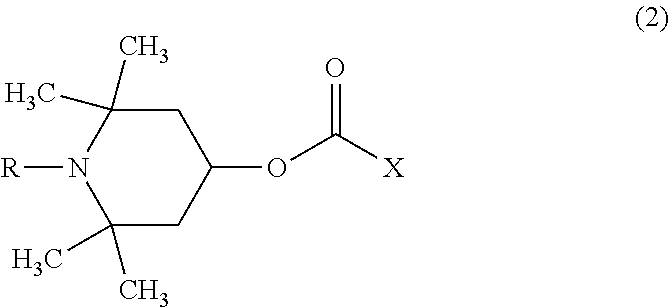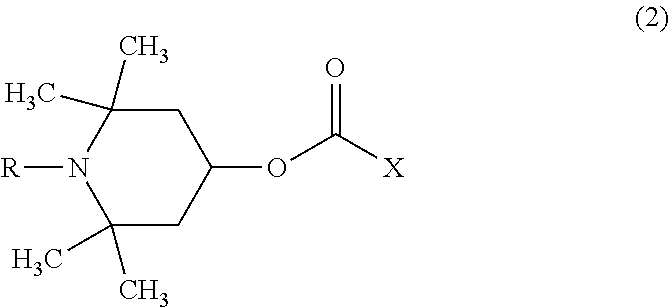Polymerizable composition for optical materials
a technology of polymerizable composition and optical material, which is applied in the direction of optics, optical elements, instruments, etc., can solve the problems of difficult to obtain high strength, distortion or white turbidity in cured products, and high cost of resin gaskets, so as to reduce the elution of adhesives, easy to produce optical materials industrially, and reduce the yellowing of cured products
- Summary
- Abstract
- Description
- Claims
- Application Information
AI Technical Summary
Benefits of technology
Problems solved by technology
Method used
Image
Examples
example 1
[0075]75.0 parts by mass of bis(β-epithiopropyl)sulfide as the compound (a), 11.3 parts by mass of m-tetramethyl xylylene diisocyanate as the compound (b), 13.7 parts by mass of m-xylylenedithiol as the compound (c) and 0.025 part by mass of pentamethylpiperidyl methacrylate as the compound (d) were mixed together and subjected to a thiourethanation preliminary reaction at 20° C. for 16 hours, and it was confirmed that the consumption of the isocyanate group of the compound (b) was 80% by FT-IR. Further, it was confirmed that the consumption of the episulfide group was less than 1% by FT-IR. The viscosity of the preliminary reaction solution at 20° C. was 50 cP. With this preliminary reaction solution, 0.025 part by mass of tetrabutylphosphonium bromide as a polymerization catalyst, 0.01 part by mass of dibutyltin dichloride as a polymerization modifier and 1.0 part by mass of 2-(2-hydroxy-5-tert-octylphenyl)benzotriazole as a ultraviolet absorber were mixed to produce a homogeneous...
example 2
[0077]80.0 parts by mass of bis(β-epithiopropyl)sulfide as the compound (a), 8.4 parts by mass of m-tetramethyl xylylene diisocyanate as the compound (b), 11.6 parts by mass of m-xylylenedithiol as the compound (c), 0.025 part by mass of pentamethylpiperidyl methacrylate as the compound (d) and 1.0 part by mass of 2-(2-hydroxy-5-tert-octylphenyl)benzotriazole as a ultraviolet absorber were mixed together and subjected to a thiourethanation preliminary reaction at 25° C. for 10 hours, and it was confirmed that the consumption of the isocyanate group of the compound (b) was 76% by FT-IR. Further, it was confirmed that the consumption of the episulfide group was less than 1% by FT-IR. The viscosity of the preliminary reaction solution at 20° C. was 45 cP. With this preliminary reaction solution, 0.020 part by mass of tetrabutylphosphonium bromide as a polymerization catalyst was mixed to produce a homogeneous polymerizable composition. The obtained polymerizable composition was subject...
example 3
[0079]50.0 parts by mass of bis(β-epithiopropyl)sulfide as the compound (a), 28.3 parts by mass of m-tetramethyl xylylene diisocyanate as the compound (b), 21.7 parts by mass of m-xylylenedithiol as the compound (c), 0.050 part by mass of pentamethylpiperidyl methacrylate as the compound (d) and 1.0 part by mass of 2-(2-hydroxy-5-tert-octylphenyl)benzotriazole as a ultraviolet absorber were mixed together and subjected to a thiourethanation preliminary reaction at 30° C. for 6 hours, and it was confirmed that the consumption of the isocyanate group of the compound (b) was 70% by FT-IR. Further, it was confirmed that the consumption of the episulfide group was less than 1% by FT-IR. The viscosity of the preliminary reaction solution at 20° C. was 80 cP. With this preliminary reaction solution, 0.025 part by mass of tetrabutylphosphonium bromide as a polymerization catalyst and 0.02 part by mass of dibutyltin dichloride as a polymerization modifier were mixed to produce a homogeneous ...
PUM
| Property | Measurement | Unit |
|---|---|---|
| viscosity | aaaaa | aaaaa |
| temperature | aaaaa | aaaaa |
| temperature | aaaaa | aaaaa |
Abstract
Description
Claims
Application Information
 Login to View More
Login to View More - R&D
- Intellectual Property
- Life Sciences
- Materials
- Tech Scout
- Unparalleled Data Quality
- Higher Quality Content
- 60% Fewer Hallucinations
Browse by: Latest US Patents, China's latest patents, Technical Efficacy Thesaurus, Application Domain, Technology Topic, Popular Technical Reports.
© 2025 PatSnap. All rights reserved.Legal|Privacy policy|Modern Slavery Act Transparency Statement|Sitemap|About US| Contact US: help@patsnap.com



